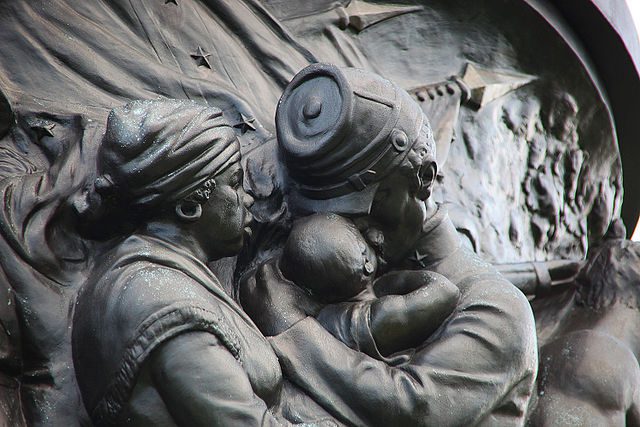‘Loyal Slave’ Monuments Tell a Racist Lie About American History
These monuments—nearly all of them still standing—prop up the fantasy that slaves were happy, loyal, and devoted to those who enslaved them.
By Kali Holloway
The following is an excerpt of an article that was originally published on The Nation. Click to read the full article online.
As America’s racist historical myths go, the loyal black slave is one of the most enduring, destructive, and tightly held. Emerging from the white Southern racial imagination in the 1830s, the faithful slave personified slave owners’ defensiveness against a growing abolitionist movement and its condemnations of slavery, and slaveholders, as evil and immoral. The loyal-slave trope insisted that enslaved blacks labored for their enslavers not out of self-preservation and deeply instilled fear, but as an expression of love, fidelity, and devotion. After the Civil War ended in their humiliating defeat, white Southerners attempted to retroactively justify the Confederacy with the “Lost Cause” ideology, an ahistorical narrative that further reimagined the Old South as filled with happy enslaved blacks. The loyal slave became a stock character in slavery apologia from Gone with the Wind to pancake-mix ad campaigns to—perhaps less famously—a little-known subgenre of Confederate monuments. Nearly all of those overtly racist memorials still stand in sites around the South.
As with Confederate monuments generally, loyal-slave markers communicated not only the white South’s nostalgia for a counterfeit version of what once was, but also its belief in what should have been. Constructed not during slavery but between the 1900s and 1930s, like nearly all Confederate monuments, loyal-slave markers served as the visible component of an anti-black backlash against black civil-rights gains. In the face of African-American empowerment struggles, loyal-slave monuments telegraphed the idea that slavery had been the natural state of things. Faithful-slave markers also warned black folks working to overturn the racial-caste system in the late-19th and early-20th centuries that they risked the same brutal violence that had kept racial order during slavery. In fact, black defiance had manifested in 250 slave uprisings, more than 100,000 escapes via the Underground Railroad, and thousands more escaped slaves’ joining the Union Army before slavery was abolished in 1865.
[…]
The above is an excerpt of an article that was originally published on The Nation. Click to read the full article online.

